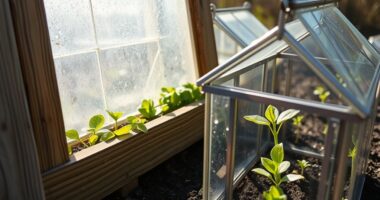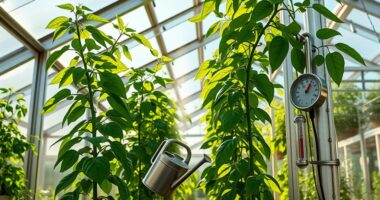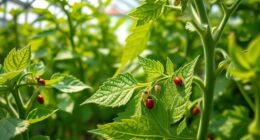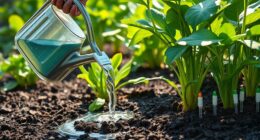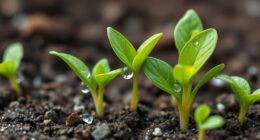Greenhouse terminology can help you understand how structures, equipment, and environmental controls work together. Terms like glazing refer to materials like glass or polycarbonate that let light in, while ventilation involves fans and vents that regulate airflow. Climate control includes devices like heaters, cooling pads, and shade cloths that manage temperature and humidity. Learning these key words makes it easier to plan and operate your greenhouse effectively—continue exploring to reveal more helpful details.
Key Takeaways
- Greenhouse terminology includes terms for structures, glazing, ventilation, climate control, and support systems essential for beginners.
- Understanding terms like “ventilation,” “insulation,” and “thermostat” helps in managing greenhouse environments effectively.
- Glossaries explain key concepts such as “exhaust fans,” “shade cloths,” and “thermal mass” for better system comprehension.
- Familiarity with these terms enhances decision-making on design, equipment, and environmental management.
- A solid grasp of greenhouse vocabulary supports proper maintenance, troubleshooting, and optimizing plant growth environments.
Basic Greenhouse Structures and Designs

Greenhouses come in various structures and designs, each suited to different growing needs and environments. When choosing a design, consider your glazing options, as they affect light transmission and insulation. Common glazing materials include glass, polycarbonate, and plastic film, each offering different benefits. The greenhouse orientation is also vital; positioning it to maximize sunlight exposure helps optimize plant growth. For example, orienting the structure east-west ensures even light distribution throughout the day, while north-south orientation can maximize sunlight in winter. Your choice of structure, glazing, and orientation impacts the greenhouse’s efficiency and suitability for specific plants. Additionally, selecting diverse designs can enhance indoor aesthetics and better suit your space and plant types. Considering climate considerations during design selection can further improve plant health and energy efficiency. Proper ventilation and temperature regulation are also essential factors to account for optimal plant growth and health. Understanding ventilation systems helps maintain appropriate humidity levels and air circulation, which are crucial for healthy plant development. Integrating insulation techniques can also help maintain consistent temperatures, especially in colder climates, ensuring a stable environment for your plants.
Climate Control and Ventilation Terms
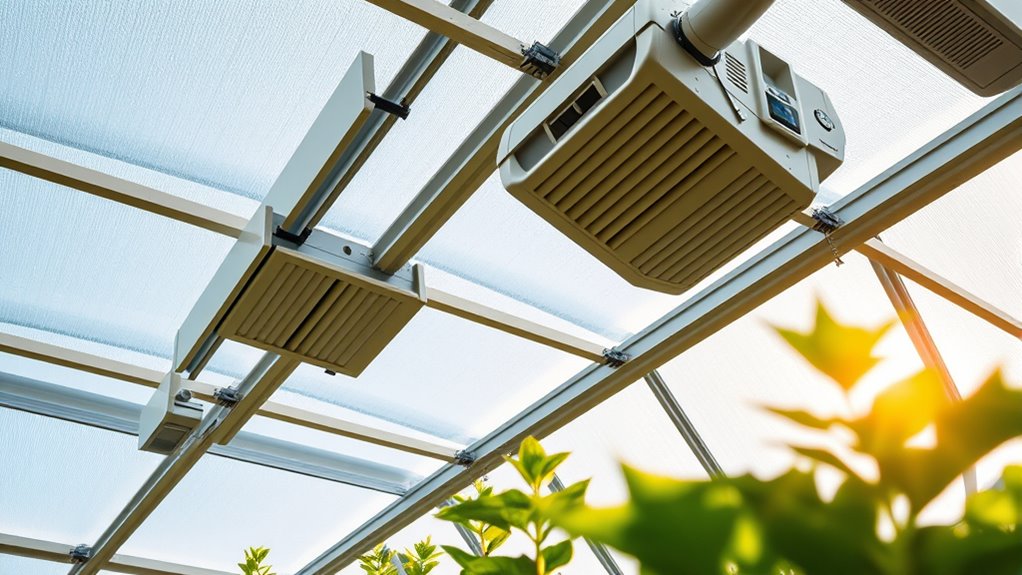
You’ll want to understand how ventilation systems help regulate airflow and humidity inside your greenhouse. Proper air circulation can prevent issues such as mold and ensure even temperature distribution. Additionally, understanding humidity control techniques can help you maintain optimal moisture levels for your plants’ health. Temperature regulation techniques, like fans and shading, keep conditions ideal for your plants. Getting familiar with these terms ensures you can choose the right climate control solutions for your setup. Using air quality monitoring devices can further assist in maintaining ideal growing conditions and prevent potential problems before they occur. Incorporating ventilation system design principles can optimize airflow and improve overall climate stability within your greenhouse. Moreover, leveraging AI-driven automation can enhance the precision of climate controls, ensuring consistent and optimal environmental conditions for your plants.
Ventilation Systems Overview
Effective ventilation systems are essential for maintaining ideal climate conditions inside a greenhouse, ensuring healthy plant growth and preventing issues like excess humidity or temperature fluctuations. You achieve this through proper air exchange, which involves replacing stale air with fresh air to regulate humidity and carbon dioxide levels.
The airflow rate, or how quickly air moves through your greenhouse, directly impacts the effectiveness of ventilation. A high airflow rate ensures rapid removal of hot, humid air and delivers fresh air efficiently. Additionally, selecting the appropriate ventilation system configuration can optimize airflow and climate control based on your specific greenhouse layout. Proper system design is also crucial for air circulation, which helps prevent dead zones and promotes even climate distribution throughout the space. Incorporating fan placement strategies can further enhance overall airflow uniformity and effectiveness. Understanding climate control technologies can help you choose the right systems to automate and fine-tune conditions for optimal plant health.
Implementing automated controls can further enhance climate regulation, making it easier to maintain consistent conditions tailored to your plants’ needs. Different systems, such as exhaust fans, roof vents, and sidewall vents, work together to optimize air exchange. By maintaining appropriate airflow rates, you prevent stagnation and promote a healthy, balanced environment for your plants to thrive.
Temperature Regulation Techniques
Maintaining ideal temperature inside a greenhouse involves a combination of climate control methods and understanding key ventilation terms. Humidity control plays an essential role, as too much moisture can lead to mold and plant diseases, while too little causes stress. You can manage humidity with proper ventilation and dehumidifiers. Proper ventilation is crucial for maintaining healthy air circulation and preventing hot spots, which can be caused by uneven heat distribution. Cooling methods, such as exhaust fans, shade cloths, and evaporative cooling systems, help prevent overheating during hot days. Proper airflow ensures heat is dissipated efficiently and maintains consistent temperatures. Incorporating automated climate control systems can further optimize environmental conditions by adjusting airflow and temperature based on real-time sensor data. Additionally, selecting appropriate wicking materials enhances moisture regulation and climate stability within the greenhouse environment. Using climate monitoring sensors allows for precise adjustments, ensuring optimal conditions are maintained at all times. Understanding and implementing these ventilation practices and humidity control techniques creates a stable environment for your plants. By understanding these key concepts, you can optimize your greenhouse’s climate, promoting healthy growth and maximizing crop yields.
Common Plant Types Grown in Greenhouses
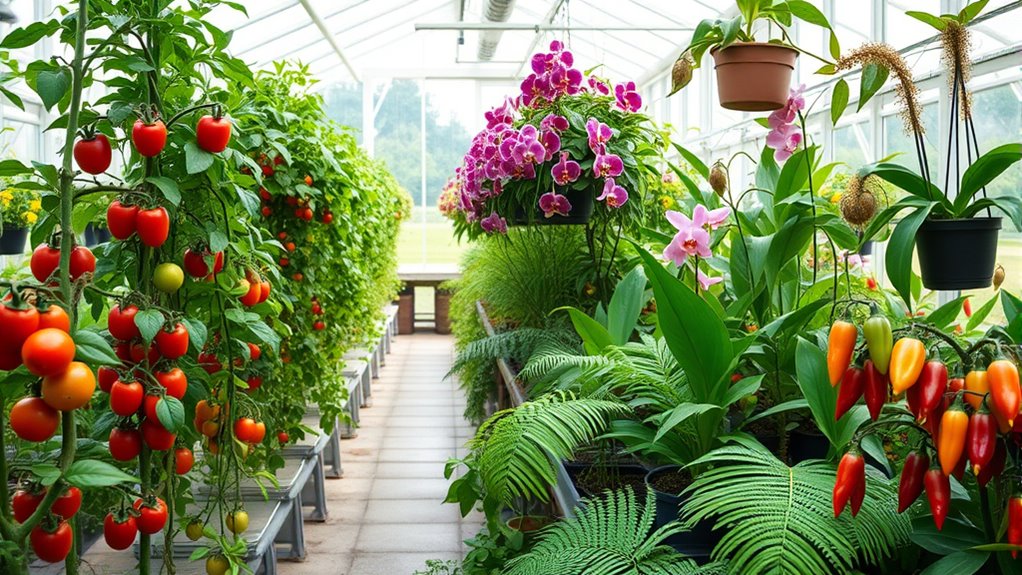
Greenhouses are ideal environments for cultivating a variety of plant types that thrive in controlled conditions. You’ll find succulent varieties flourishing here because they prefer warm, dry environments with plenty of sunlight. They require minimal watering and adapt well to greenhouse settings.
Tropical plants are also popular, as greenhouses can mimic their native humid, warm climates, allowing you to grow orchids, ferns, and other lush species year-round. These plants often need consistent warmth and humidity, which greenhouses provide easily.
Greenhouse Equipment and Tools
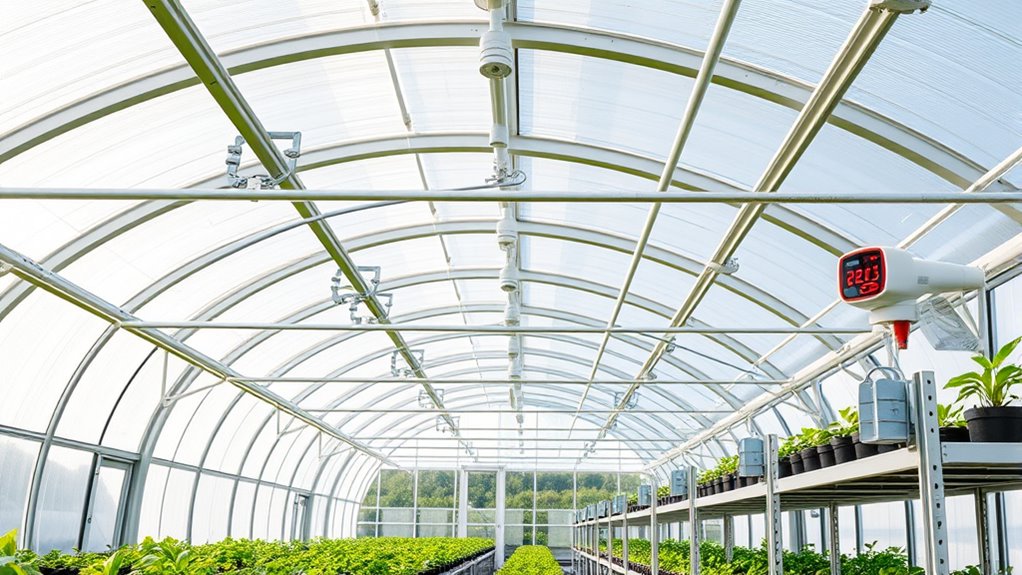
To keep your greenhouse running smoothly, you need the right equipment and tools. Heating and cooling devices control temperature.
While ventilation system components guarantee proper airflow. Watering and drainage tools help you maintain ideal moisture levels for healthy plant growth.
Heating and Cooling Devices
Heating and cooling devices are essential tools that help you regulate the temperature inside a greenhouse, ensuring ideal conditions for plant growth. Proper thermostat settings keep temperatures stable, preventing stress on your plants. Heater placement is vital; position heaters where they distribute warmth evenly without creating hotspots. For example, placing heaters near the center or along walls can maximize efficiency. Consider using the table below to understand key devices:
| Device Type | Purpose |
|---|---|
| Thermostat | Controls temperature settings |
| Space Heaters | Provide localized warmth |
| Ventilation Fans | Remove excess heat |
| Cooling Pads | Lower temperature through evaporation |
| Shade Cloths | Reduce heat gain |
Ventilation Systems Components
Ever wondered how proper airflow maintains ideal conditions inside a greenhouse? Ventilation system components play a vital role in guaranteeing good air circulation. You’ll find exhaust fans at the heart of this system—they actively remove stale, warm air and draw in fresh air from outside. These fans help regulate temperature, humidity, and CO2 levels, preventing overheating and mold growth.
Besides exhaust fans, you’ll also encounter intake vents and louvers, which control how much outside air enters the space. Proper placement and operation of these components create a steady airflow, keeping your greenhouse environment balanced.
Regular maintenance of exhaust fans and vents guarantees they work efficiently, helping your plants thrive by providing perfect air quality and temperature conditions at all times.
Watering and Drainage Tools
Efficient watering and drainage tools are essential for maintaining healthy plant growth inside a greenhouse. Proper drainage systems prevent overwatering and root rot, ensuring excess water flows away from your plants. Installing trays, gutters, or specialized drainage mats helps manage runoff effectively.
When it comes to watering, using quality watering cans allows you to control the amount and direction of water precisely. Look for cans with adjustable nozzles to avoid over-saturating delicate plants.
Consistent watering combined with good drainage keeps soil moisture balanced, promoting healthy roots. Regularly inspect your drainage systems to prevent clogs.
Soil, Growing Media, and Fertilizers

Have you ever wondered what makes a plant thrive in a greenhouse? It all comes down to soil, growing media, and fertilizers. Choosing the right growing medium guarantees proper drainage and aeration. Here are three key points to consider:
- Use soil amendments to improve fertility and structure, making nutrients more accessible.
- Select appropriate fertilizer formulations tailored to your plants’ needs to promote healthy growth.
- Maintain proper pH levels in your soil or media for ideal nutrient uptake.
Light and Temperature Regulation
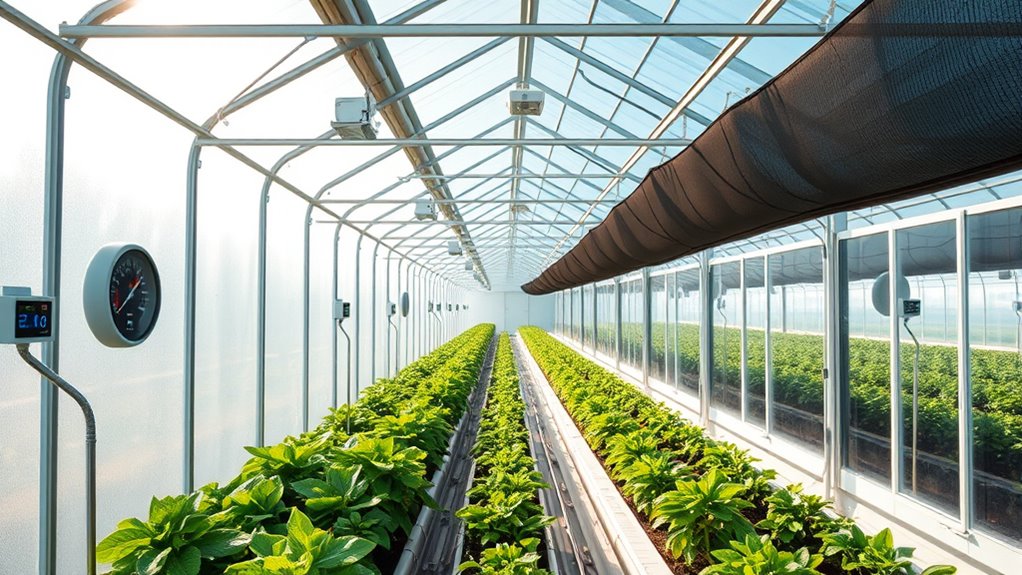
Ensuring light and temperature conditions in your greenhouse directly influences plant growth and health. You can control light intensity by adjusting shading or using supplemental lighting to make certain plants receive enough light without overheating.
Proper ventilation helps manage temperature fluctuation, preventing it from becoming too extreme. Consistent temperatures promote steady growth, so monitor and adjust your heating or cooling systems as needed.
During colder months, use heaters or thermal mass to retain warmth, while in hot weather, fans or shade cloths can reduce heat buildup.
Maintenance and Troubleshooting Vocabulary
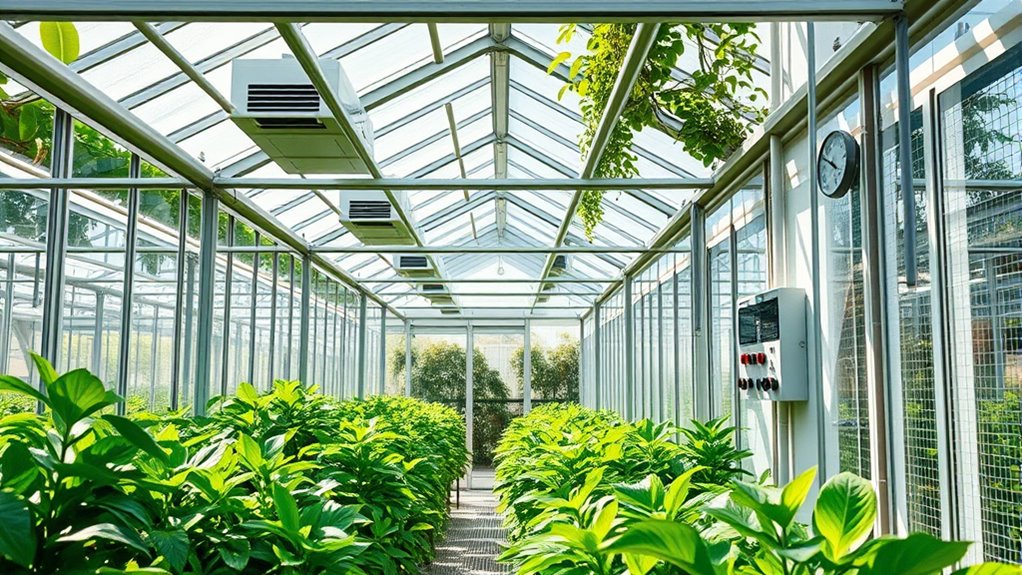
Maintaining your greenhouse requires understanding key troubleshooting terms and routine procedures to keep systems running smoothly. Knowing essential maintenance vocabulary helps you identify problems early and apply effective pest control strategies.
Here are three troubleshooting tips to get you started:
- Diagnose pest issues quickly by inspecting plants for signs like holes or discolored leaves, and use targeted pest control methods.
- Check ventilation systems regularly to prevent humidity buildup, which can lead to mold or pest infestations.
- Monitor irrigation systems for leaks or clogs, ensuring plants aren’t over- or under-watered, reducing stress that attracts pests.
Mastering these terms and procedures keeps your greenhouse healthy, minimizes pest problems, and maintains ideal growing conditions.
Frequently Asked Questions
How Do I Choose the Right Greenhouse Size for My Space?
When choosing the right greenhouse size, consider your available space and what you plan to grow. Think about installing drip irrigation to efficiently water your plants and solar lighting to save energy.
Measure your area carefully and decide if a small, medium, or large greenhouse suits your needs. A larger space offers more growth potential, but guarantee it fits comfortably in your yard or garden to make the most of your setup.
What Are the Best Plants for Beginner Greenhouse Growers?
Think of your greenhouse as a nurturing nest; starting with easy plants makes the process smooth. Beginners often find herbs like basil and mint perfect—they thrive with minimal fuss.
Tomatoes and lettuce are also ideal, especially when practicing plant propagation. Companion planting can boost growth and deter pests, making your greenhouse more productive.
These plants build confidence, just like a child learning to walk, setting a sturdy foundation for future gardening adventures.
How Often Should I Check and Adjust Greenhouse Humidity Levels?
You should check and adjust your greenhouse humidity levels daily to maintain ideal conditions. Regular humidifier maintenance ensures it functions properly, preventing issues like mold.
Place humidity sensors strategically—away from direct sunlight and vents—to get accurate readings. Adjust humidity settings based on sensor data, and monitor changes throughout the day.
Consistent checks help you create a stable environment, promoting healthy plant growth and avoiding problems caused by too high or low humidity.
Can I Automate Greenhouse Climate Control Systems?
Yes, you can automate your greenhouse climate control systems.
By installing climate sensors, you gain real-time data on temperature and humidity, while automation software adjusts fans, heaters, and vents automatically. This setup helps maintain ideal conditions efficiently, reducing manual effort.
You’ll find that automation improves plant health and saves time, allowing you to focus on other gardening tasks. Just ensure your sensors and software are compatible for seamless operation.
What Are Eco-Friendly Options for Greenhouse Pest Management?
Like Daedalus’s wings, eco-friendly pest management lifts you toward sustainable practices. You can utilize biological controls, introducing beneficial insects that naturally curb pests, or opt for organic pesticides, which minimize environmental impact.
These options work harmoniously with your greenhouse, reducing chemical reliance and protecting your crops. By choosing biological controls and organic pesticides, you embrace a greener future—one where pest management aligns with ecological balance and sustainability.
Conclusion
Now that you’ve explored the world of greenhouse terminology, you’re like a gardener holding a key to a lush, thriving oasis. With each term you’ve learned, you can visualize a vibrant greenhouse bursting with life and growth. Think of this knowledge as your trusty compass, guiding you through every season and challenge. Embrace it, and watch your green space flourish—your journey into greenhouse mastery has just begun.




